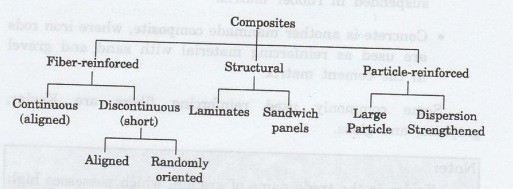Physics For Civil Engineering: Unit IV: New Engineering Materials
Classification of Composites
It is difficult to categorize all the composites because with the advancement in technology, new and better composites are developed everyday.
CLASSIFICATION OF COMPOSITES
It is difficult to categorize all the
composites because with the advancement in technology, new and better
composites are developed everyday.
Based on the reinforcement techniques,
composites are classified
as:
(a)
Fiber-reinforced
(b)
Structural
(c)
Particle-reinforced

Fiber - Reinforced
Fiber-reinforced
composites consist of thin fibers of a material, which are suspended in a
matrix of another material. Matrix is the medium or the substance in which the
fibers are suspended.
Matrix
distributes the stress across the fibers. The thin continuous or discontinuous
fibers provide strength to the composite. Matrix also provides toughness to the
fiber-reinforced structure.
Example:
Figure
4.2 shows the structure of fiber-reinforced composites.

• One roof ethe in most common natural
fiber-reinforced composite is bamboo, where cellulose fibers are suspended in a
matrix of lignin.
•
One of the manmade fiber-reinforced composites can be seen in a car tyre, where
nylon or steel wires are suspended in rubber matrix.
•
Concrete is another manmade composite, where iron rods are used as reinforcing
material with sand and gravel beoroin the cement matrix.
Some
commonly used reinforcing fibers are Kevlar, graphite, and
glass.
Note:
Kevlar
is the trade name of aramid, which possesses high specific strength.
The properties of a composite vary with the proportion of fiber used for reinforcement. Advanced fiber-reinforced composites may contain fiber content as high as 50%. Due to high fiber content, such composite materials are strong, stiff and lightweight.
Matrix
materials
In composites, the matrix phase serves
important functions. First it binds the reinforcement (fibers) together. It
acts as a medium and transmits and distributes the external loads to the
fibers.
Only
a very small proportion of applied load is sustained by the matrix phase. The
reinforcement takes up the bulk of the applied load. The matrix material should
be ductile.
The
second function of the matrix is to protect the individual fibers from surface
damage due to mechanical abrasion or chemical reaction with the environment.
Finally the matrix separates the fibers.
Due to its relative softness and plasticity it prevents the propagation of
brittle cracks from fiber to fiber which may result in catastrophic failure.
In
order to minimize fiber pull out, it is essential to have high adhesive forces
between the fiber and matrix.
The
strength of the resulting composite depends to a large extent on the magnitude
of bonding strength between fiber and matrix. The bonding ensures proper stress
transmittance from the weak matrix to the strong fibers.
Reinforced materials
In composite materials, the
reinforcement is responsible for higher strengths. Two main forms of
reinforcements used are:
(a)
Fibers
(b)
Particles
(a)
Fibers:
The materials used for reinforcing fibers have high tensile strength. Based on
the diameter and character, fibers are classified as follows.
(i)
Whiskers:
These are very thin crystals with extremely large length to diameter ratio.
Because To my olgu of their small size they have perfect crystalline beau need
evan structure and are free from flaws.
Hence,
they have exceptionally high strength and are the strongest of all known
materials. Some of the common whisker materials include graphite, silicon
carbide, silicon nitride and aluminium oxide.
(ii)
Fibers: The fibers are either polycrystalline or amorphous
materials having small diameters. Fibrous materials are generally either
polymers or ceramics.
Some common fibers used are polymer
aramids, glass, carbon, boron, aluminium oxide, silicon carbide etc.
(iii) Wires: Wires have relatively large
diameter compared to fibers. Typical materials include steel, molybdenum
and tungsten.
The arrangement or orientation of the
fiber, fiber concentration and distribution, all have a significant influence
on the strength of the composites. The three types of orientation of fibers are
shown in fig. 4.3.

(b) Particles: The particles having size of upto
lum or more in the concentrations of 20 to 40% have been used in composites.
Several
metal particles such as tungsten, chromium, molybdenum etc, can be suspended in
ductile matrix.
Non metallic particles such as ceramics
can be suspended in metal matrix. The several metal oxides and carbides in the
form of particles are used to produce metal matrix composites (MMC's).
Types of composites
Based
on the matrix material the different types of composites are
• Polymer matrix
composites: In this the matrix material is a
polymer, reinforced by ceramic. For example carbon or glass fiber reinforced
with plastics. Typical polymer matrix resins are epoxy, polyester, vori tua
polyamide, and thermoplastics. Reinforcements are glass, woled quartz fiber and
Kevlar.
• Metal matrix composites: In this composite, the matrix is a
pure metal or an alloy and the reinforcement is a ceramic phase. Typical
examples of metal matrix composites are Al - Al2O3 and
Al-SiC.
• Ceramic matrix composites: The matrix and reinforcements are
generally ceramics. In these composites the stiffness and hardness of ceramics
is combined with toughness of polymers or metals. Typical examples of ceramic
matrix composites are glass-and carbon-fiber-reinforced plastics.
Physics For Civil Engineering: Unit IV: New Engineering Materials : Tag: : - Classification of Composites
Related Topics
Related Subjects
Physics for Civil Engineering
PH3201 2021 Regulation | 2nd Semester Civil Dept 2021 Regulation
